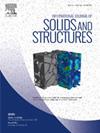几何曲率效应诱导的双螺旋结构扭转力学
IF 3.4
3区 工程技术
Q1 MECHANICS
International Journal of Solids and Structures
Pub Date : 2025-04-04
DOI:10.1016/j.ijsolstr.2025.113369
引用次数: 0
摘要
航空航天技术的飞速发展,不断推动了扭转结构轻量化和系统化设计的需求,先进复合材料在扭转结构设计中备受期待。双螺旋结构已被开发,以引入大轴向扭转能力,其中薄壁固化复合带与纵向曲率被预应力或压平,以作为形状变化的单位,然后使用刚性辐条,销,或腹板组装;然而,它的扭转性能容易受到热效应的影响,并受到预制弯曲条的压扁和组装引起的曲率变化的影响。在此,我们提出了一种新颖的双螺旋结构设计,其中具有横向曲率的薄壁弯曲带作为无预应力的变形单元。采用各向同性横弯带、各向异性平带和各向异性横弯带制备了双螺旋结构,并对其几何曲率效应引起的扭转力学进行了研究。建立了不可扩展壳模型,分析了结构的形状变化过程,揭示了结构稳定性的调节机理。实验和有限元分析研究了材料和几何曲率的相关性。发现材料的正交异性有助于螺旋结构的双稳定性;几何曲率提高了双螺旋的刚度和变形稳定性。并对扭转机理进行了详细的总结。这些发现有望促进可展开复合材料结构在航空航天工程中的扭转结构设计和应用。本文章由计算机程序翻译,如有差异,请以英文原文为准。
Geometric curvature effects-induced twisting mechanics of a double helical structure
The rapid development of aerospace technology has continuously promoted the demand for lightweight and systematic design of twisting structures, where advanced composites have drawn great expectations. A double helical structure has been developed to introduce large axial twistable capability, where thin-walled cured composite strips with a longitudinal curvature were prestressed or flattened to be employed as shape-changing units, and then assembled by using rigid spokes, pins, or webs; however, its twisting performance would be susceptible to thermal effects, and affected by the curvature variations induced by flattening and assembling of the precured curved strips. Here, we proposed a novel double helical structural design, where thin-walled curved tapes with transverse curvature were applied as the shape-changing units without prestressing. The double helical structures were produced and investigated with isotropic transverse curved tapes, orthotropic flat strips, as well as orthotropic transverse curved tapes, in order to reveal its geometric curvature effects-induced twisting mechanics. An inextensible shell model was formulated to analyse the shape-changing process, and expose the regulating mechanisms on structural stability. Experiments and finite element analysis were carried out to investigate the material and geometric curvature dependencies. It is found that the material orthotropy contributes to the bistability of the helical structure; geometric curvature promotes the stiffness and shape-changing stability of the double helix. The twisting mechanisms were then concluded in detail. These findings are expected to facilitate torsional structural design and application of deployable composite structures for aerospace engineering.
求助全文
通过发布文献求助,成功后即可免费获取论文全文。
去求助
来源期刊
CiteScore
6.70
自引率
8.30%
发文量
405
审稿时长
70 days
期刊介绍:
The International Journal of Solids and Structures has as its objective the publication and dissemination of original research in Mechanics of Solids and Structures as a field of Applied Science and Engineering. It fosters thus the exchange of ideas among workers in different parts of the world and also among workers who emphasize different aspects of the foundations and applications of the field.
Standing as it does at the cross-roads of Materials Science, Life Sciences, Mathematics, Physics and Engineering Design, the Mechanics of Solids and Structures is experiencing considerable growth as a result of recent technological advances. The Journal, by providing an international medium of communication, is encouraging this growth and is encompassing all aspects of the field from the more classical problems of structural analysis to mechanics of solids continually interacting with other media and including fracture, flow, wave propagation, heat transfer, thermal effects in solids, optimum design methods, model analysis, structural topology and numerical techniques. Interest extends to both inorganic and organic solids and structures.

 求助内容:
求助内容: 应助结果提醒方式:
应助结果提醒方式:


